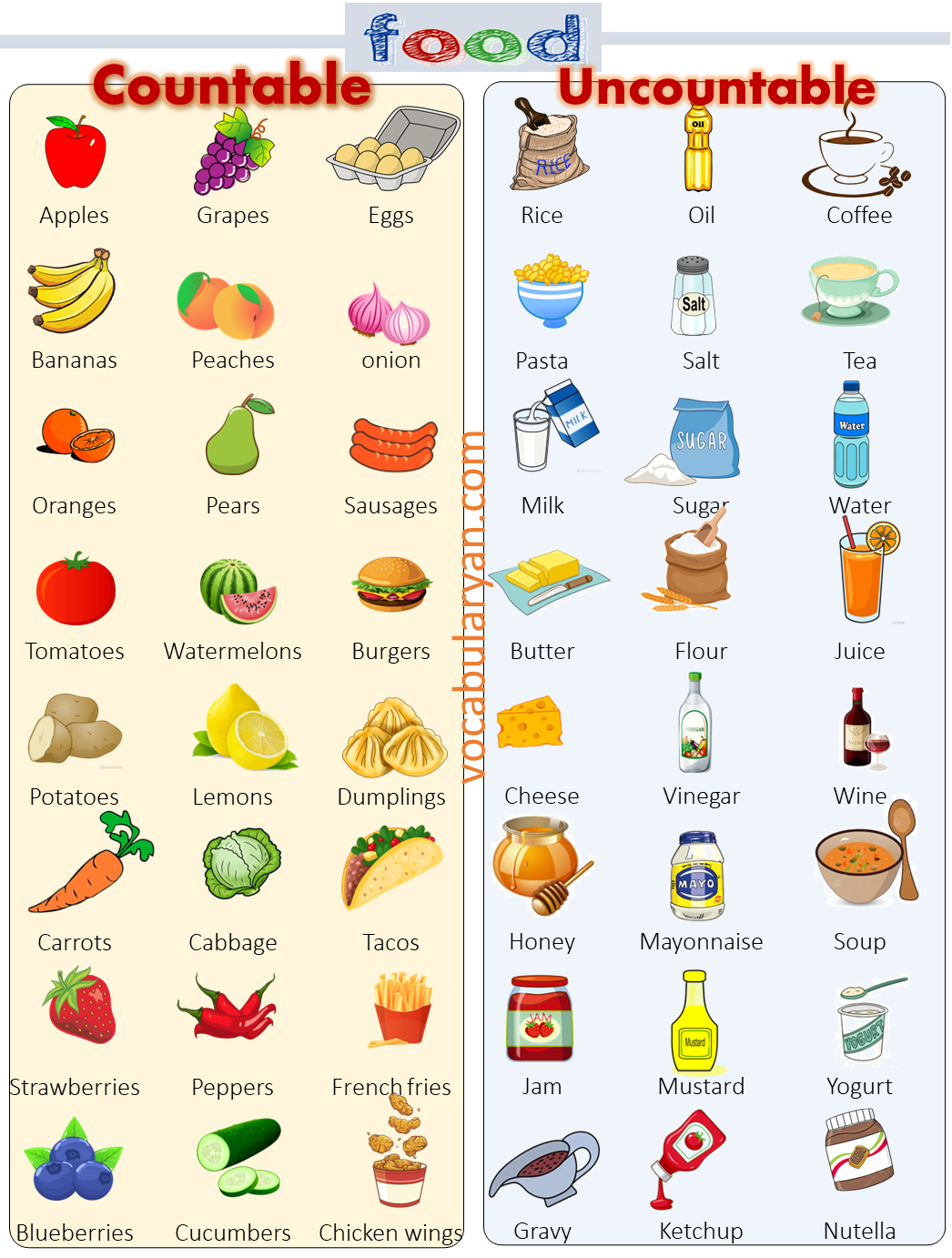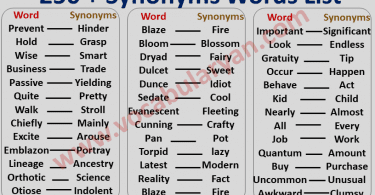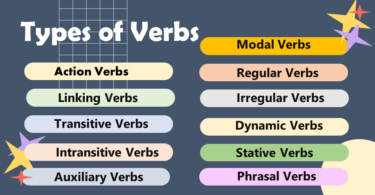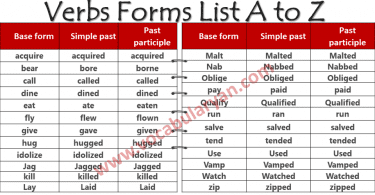Understanding countable and uncountable nouns is fundamental for using English grammar correctly. Countable nouns refer to items you can count, like books, apples, or chairs, and they have singular and plural forms. In contrast, uncountable nouns represent things that can’t be counted individually, such as water, rice, or music, and they usually don’t have a plural form. Learning the difference helps with proper article use, verb agreement, and quantity expressions, making your communication clearer and more accurate.
Countable nouns
Definition: Countable nouns refer to individual items, people, or things that can be counted as separate units. They can have both singular and plural forms.
Example: apple, book, car, dog, chair, student, house, pencil, computer, cup, etc.
Grammatical Characteristics:
• Can be used with both singular and plural articles (a, an, the, these, those, etc.).
• Can be preceded by numbers (one book, two cars) and quantifiers (some, many, few, several, etc.).
• Take plural forms when referring to more than one item (apples, books, cars, etc.).
• Require plural verbs when used in sentences (The books are on the shelf).
Examples of Countable Nouns:
- Apples
- I bought three apples from the grocery store.
- Books
- She has a collection of fantasy books on her shelf.
- Cats
- The neighborhood has many cats roaming around.
- Dogs
- Our family has two dogs, a Labrador and a poodle.
- Chairs
- The dining room has six chairs around the table.
- Students
- The school organized a field trip for the students.
- Hats
- He tried on several hats before choosing one for the party.
- Balls
- The kids were playing with colorful balls in the park.
- Cars
- My neighbor has a garage full of vintage cars.
- Pencils
- Can I borrow one of your pencils for the exam?
Countable Nouns List
Countable nouns are things we can count individually using numbers. Examples include apple, chair, book, car, and pen. These nouns can be used with a, an, many, few, and numbers to show quantity clearly.
- Apple
- Ball
- Cat
- Dog
- Elephant
- Flower
- Guitar
- Hat
- Ice cream
- Jacket
- Kite
- Lemon
- Mango
- Notebook
- Orange
- Penguin
- Quilt
- Rabbit
- Shoe
- Table
- Umbrella
- Violin
- Watch
- Xylophone
- Yogurt
- Zebra
- Banana
- Car
- Duck
- Frog
- Grapes
- Hammer
- Igloo
- Jellybean
- Kangaroo
- Lamp
- Mouse
- Nut
- Octopus
- Pineapple
- Quilt
- Rocket
- Sunflower
- Tomato
- Unicorn
- Volcano
- Watermelon
- X-ray
- Yarn
- Zucchini
- Backpack
- Camera
- Donut
- Earrings
- Football
- Guitar
- Hat
- Ice skates
- Jeans
- Kite
- Lollipop
- Mittens
- Necklace
- Onion
- Pizza
- Quilt
- Rainbow
- Socks
- Toothbrush
- Umbrella
- Violin
- Wallet
- Xylophone
- Yo-yo
- Zebra
- Bag
- Chair
- Desk
- Eraser
- Fan
- Globe
- Hammer
- Ink
- Juice
- Kettle
- Lantern
- Mirror
- Newspaper
- Oven
- Pillow
- Quilt
- Rug
- Spoon
- Table
- Umbrella
- Vase
- Window
- Xylophone
- Yarn
- Zipper

Uncountable nouns
Uncountable nouns refer to substances, concepts, or things that cannot be counted as separate units. They do not have a plural form and are considered singular.
Examples: water, milk, sugar, information, furniture, rice, money, advice, music, weather, etc.
Grammatical Characteristics:
• Generally, do not take an indefinite article (a, an) because they can’t be counted as discrete units (You can’t say “a water” or “a furniture”).
• Use “some,” “much,” “a little,” “a lot of,” etc., as quantifiers to indicate quantity.
• Do not have a plural form and are always treated as singular (Water is essential for life).
• Use singular verbs in sentences (The music is playing softly).
• It’s important to note that some nouns can be countable or uncountable depending on the context. For example, “time” can be both countable (two times) and uncountable (time is precious).
• Also, some nouns might have different meanings as countable and uncountable nouns. For instance, “wine” can refer to a drink (uncountable) or to specific types or bottles of wine (countable).
• Understanding the distinction between countable and uncountable nouns is crucial for using them correctly.
Examples of Uncountable Noun
- Water
- We need to drink plenty of water to stay hydrated.
- Milk
- I like to have a glass of milk with my breakfast.
- Sugar
- Can you pass me the sugar for my coffee?
- Flour
- She used whole wheat flour to bake the bread.
- Coffee
- He enjoys the aroma of freshly brewed coffee in the morning.
- Tea
- Would you like a cup of tea with honey?
- Juice
- The kids love to have orange juice with their pancakes.
- Wine
- They brought a bottle of red wine to the dinner party.
- Air
- Clean air is important for a healthy environment.
- Bread
- The bakery makes delicious, fresh bread every day.
- Butter
- She spread butter on her toast and sprinkled cinnamon.
- Cheese
- The cheese in this lasagna is rich and creamy.
- Chocolate
- I have a weakness for dark chocolate.
- Honey
- Honey is a natural sweetener used in many recipes.
- Jam
- Would you like some toast with jam for breakfast?
- Oil
- Olive oil is often used in Mediterranean cuisine.
- Rice
- We had rice with curry for dinner last night.
- Soup
- A bowl of hot soup is perfect on a chilly day.
- Meat
- He prefers to grill meat on the weekends.
- Fish
- The restaurant serves a variety of fresh fish dishes.
List Of Uncountable Nouns
Uncountable nouns are things that cannot be counted individually. They usually refer to materials, liquids, emotions, or abstract ideas, such as water, rice, advice, and honesty. These nouns do not have a plural form and are not used with “a” or “an”.
- Water
- Milk
- Sugar
- Salt
- Flour
- Coffee
- Tea
- Juice
- Wine
- Air
- Bread
- Butter
- Cheese
- Chocolate
- Honey
- Jam
- Oil
- Rice
- Soup
- Meat
- Fish
- Chicken
- Beef
- Pork
- Lamb
- Seafood
- Gravy
- Ice cream
- Yogurt
- Cereal
- Pasta
- Rice
- Spaghetti
- Linguine
- Information
- Knowledge
- Advice
- Wisdom
- Education
- Research
- Money
- Currency
- Gold
- Silver
- Time
- Weather
- Music
- Noise
- Sound
- Silence
- Light
- Darkness
- Energy
- Heat
- Electricity
- Oxygen
- Gas
- Air
- Sand
- Soil
- Dust
- Space
- Hair
- Skin
- Leather
- Wool
- Silk
- Cotton
- Paper
- Wood
- Metal
- Plastic
- Glass
- Clay
- Cement
- Stone
- Brick
- Rubber
- Vinegar
- Mustard
- Mayonnaise
- Ketchup
- Salt
- Pepper
- Sugar
- Flour
- Gravy
- Coffee
- Tea
- Oil
- Vinegar
- Water
- Juice
- Milk
- Alcohol
- Honey
- Jam
- Butter
- Cheese
- Chocolate

List of Countable Foods
Countable foods are items that we can count one by one and use in plural form, like apples, eggs, sandwiches, or cookies. These foods are seen as separate units and can be counted easily, making them different from uncountable food items like rice or milk.
• Apples
• Bananas
• Oranges
• Tomatoes
• Potatoes
• Carrots
• Strawberries
• Blueberries
• Grapes
• Peaches
• Pears
• Watermelons
• Lemons
• Onions
• Peppers (bell peppers)
• Cucumbers
• Eggs
• Slices of bread
• Sausages
• Burgers
• Cookies
• Cakes (slices)
• Cupcakes
• Sandwiches
• Pieces of chocolate
• Dumplings
• Tacos
• French fries
• Chicken wings
• Fish fillets
List of Uncountable Foods
Uncountable foods are those that cannot be counted individually and are usually in bulk, liquid, or powder form. Examples include milk, flour, rice, butter, and cheese. These foods don’t have a plural form and are measured in quantity using units like “a cup of” or “some.”
• Rice
• Pasta
• Bread (as a general substance)
• Milk
• Butter
• Cheese
• Honey
• Jam
• Oil (olive oil, cooking oil, etc.)
• Salt
• Sugar
• Flour
• Coffee
• Tea
• Water
• Juice (orange juice, apple juice, etc.)
• Wine
• Soup
• Gravy
• Ice cream
• Yogurt
• Cereal (as a substance)
• Meat (in general)
• Seafood (in general)
• Chocolate (as a substance)
• Vinegar
• Mayonnaise
• Mustard
• Ketchup
• Nutella





Leave a Comment